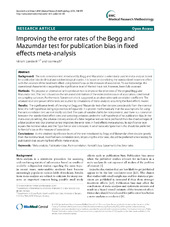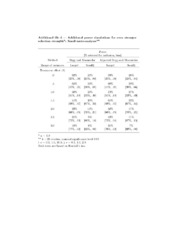| dc.contributor.author | Gjerdevik, Miriam | eng |
| dc.contributor.author | Heuch, Ivar | eng |
| dc.date.accessioned | 2014-10-08T13:06:23Z | |
| dc.date.available | 2014-10-08T13:06:23Z | |
| dc.date.issued | 2014-09-22 | eng |
| dc.identifier.issn | 1471-2288 | en_US |
| dc.identifier.uri | https://hdl.handle.net/1956/8611 | |
| dc.description.abstract | Background: The rank correlation test introduced by Begg and Mazumdar is extensively used in meta-analysis to test for publication bias in clinical and epidemiological studies. It is based on correlating the standardized treatment effect with the variance of the treatment effect using Kendall’s tau as the measure of association. To our knowledge, the operational characteristics regarding the significance level of the test have not, however, been fully assessed. Methods: We propose an alternative rank correlation test to improve the error rates of the original Begg and Mazumdar test. This test is based on the simulated distribution of the estimated measure of association, conditional on sampling variances. Furthermore, Spearman’s rho is suggested as an alternative rank correlation coefficient. The attained level and power of the tests are studied by simulations of meta-analyses assuming the fixed effects model. Results: The significance levels of the original Begg and Mazumdar test often deviate considerably from the nominal level, the null hypothesis being rejected too infrequently. It is proven mathematically that the assumptions for using the rank correlation test are not strictly satisfied. The pairs of variables fail to be independent, and there is a correlation between the standardized effect sizes and sampling variances under the null hypothesis of no publication bias. In the meta-analysis setting, the adverse consequences of a false negative test are more profound than the disadvantages of a false positive test. Our alternative test improves the error rates in fixed effects meta-analysis. Its significance level equals the nominal value, and the Type II error rate is reduced. In small data sets Spearman’s rho should be preferred to Kendall’s tau as the measure of association. Conclusions: As the attained significance levels of the test introduced by Begg and Mazumdar often deviate greatly from the nominal level, modified rank correlation tests, improving the error rates, should be preferred when testing for publication bias assuming fixed effects meta-analysis. | en_US |
| dc.language.iso | eng | eng |
| dc.publisher | BioMed Central | en_US |
| dc.rights | Attribution CC BY | eng |
| dc.rights.uri | http://creativecommons.org/licenses/by/4.0 | eng |
| dc.subject | Meta-analysis | eng |
| dc.subject | Publication bias | eng |
| dc.subject | Rank correlation | eng |
| dc.subject | Kendall’s tau | eng |
| dc.subject | Spearman’s rho | eng |
| dc.subject | Error rates | eng |
| dc.title | Improving the error rates of the Begg and Mazumdar test for publication bias in fixed effects meta-analysis | en_US |
| dc.type | Peer reviewed | |
| dc.type | Journal article | |
| dc.date.updated | 2014-10-07T15:03:59Z | |
| dc.description.version | publishedVersion | en_US |
| dc.rights.holder | Miriam Gjerdevik et al.; licensee BioMed Central Ltd. | en_US |
| dc.rights.holder | Copyright 2014 Gjerdevik and Heuch; licensee BioMed Central Ltd. | en_US |
| dc.source.articlenumber | 109 | |
| dc.identifier.doi | https://doi.org/10.1186/1471-2288-14-109 | |
| dc.identifier.cristin | 1162147 | |
| dc.source.journal | BMC Medical Research Methodology | |
| dc.source.40 | 14 | |





